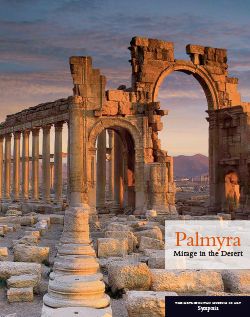Funerary relief
Not on view
Inscription:
1 Alas!
2 Nurbel, son of
3 Mokimu, (son of) Nurbel.
4 In (the month of) Qinyan, the year
5-7 492.
Transliteration:
1 ḥbl
2 nwrbl br
3 mqymw nwrbl
4 bqnyn šnt
5 4.100
6 +80
7 +10+2
This relief is a type of funerary monument characteristic of the prosperous caravan city of Palmyra during the first three centuries A.D. Reliefs with a representation of the deceased and a short identifying inscription were used to seal burial niches in elaborately decorated communal tombs; those with a half-length or bust format became prevalent sometime after A.D. 65.
The relief depicts the upper body of a bearded man dressed in a Greek garment known as a himation, which wraps around his right arm like a sling, holding a small leafy branch in his left hand. His upper eyelids are modeled, and carved circles mark the iris of each eye. The thin eyebrows and slightly narrowed, deep-set eyes give the deceased an expressive gaze, which does not meet the viewer’s but extends far into the distance. His short hair is depicted as a mass of snail-shaped curls that cover his head like a cap, with the hairline symmetrically arranged in the shape of a widow’s peak. His beard barely covers his jawline, its sparseness perhaps meant to suggest his youth. He stands in front of a blank background on which an inscription in Palmyrene Aramaic, visible to the right of his head, records his name, lineage, and the month and year of his death. The months of the Palmyrene calendar were based on the earlier Babylonian calendar, while the years were reckoned according to the Seleucid era, which began in 312 B.C.
This image cannot be enlarged, viewed at full screen, or downloaded.




